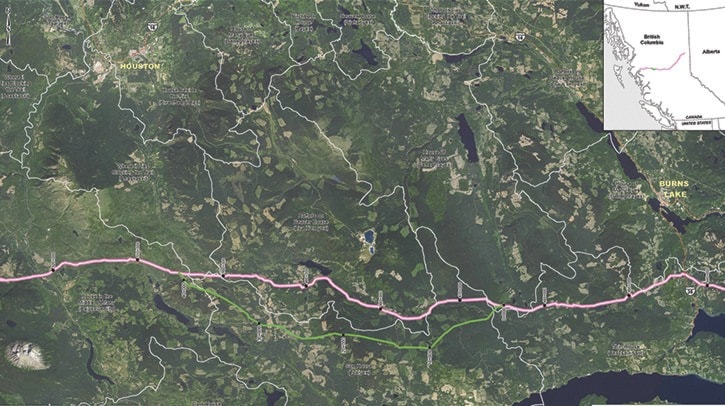TransCanada's Coastal GasLink Pipeline Ltd. is responding to feedback from Wet’suwet’en members and leaders who identified a possible alternate route that will be further away from important cultural areas.
Coastal GasLink proposes to develop a natural gas pipeline from near Dawson Creek to near Kitimat.
The Sun House alternate route is on average 3.5 km south of the approved environmental assessment certificate corridor. It begins approximately 21 km southwest of Burns Lake, and runs 41 km west (to a point approximately 25 km south of Houston).
Shela Shapiro, a spokesperson for Coastal GasLink, said no specific individual asked Coastal GasLink to consider an alternate route.
“We decided to further investigate the Sun House alternate route after feedback from Wet’suwet’en people and leaders,” she explained. “We have worked with many Wet’suwet’en people in completing the field work, and cultural areas were confidentially brought to our attention at that time.”
“Because the cultural areas were brought to our attention confidentially, I’m sure you can appreciate I can’t provide further details,” she added.
Coastal GasLink is currently conducting the work to prepare for potential applications to the Environmental Assessment Office and the B.C. Oil and Gas Commission later in 2016 to add the alternate route as an option for routing their pipeline.
"We’ll decide on the final route when we have fully considered all options," explained Jaimie Harding, Coastal GasLink's Community Relations Lead. "This includes field work, more detailed design work on construction planning, taking into account commercial, cultural and environmental considerations, as well as cost and schedule."
Coastal GasLink will conduct field work on the Sun House alternate route through the 2016 season.
"Our field work includes archaeology, engineering investigations and preconstruction surveys that will mark wildlife features, site specific vegetation, etc.," explained Harding.
Coastal GasLink has recently signed two more project agreements with First Nations groups along its pipeline route, bringing the total number of project agreements with First Nations to 13.
Kitselas First Nation and McLeod Lake Indian Band are the latest groups to sign project agreements with Coastal GasLink. These agreements outline benefits and commitments that will be provided to these communities during construction and for as long as the pipeline is in service.
“These groups have demonstrated their desire to contribute meaningfully and constructively throughout the life cycle of this project,” said Rick Gateman, Coastal GasLink President. “Our relationship with them, and the knowledge we have gained about their traditional use of the land, makes Coastal GasLink a better project.”
Coastal GasLink recently announced it has all major permits it needs to start construction of its pipeline project.
The proposed pipeline is expected to create 2000 to 2500 jobs during construction and generate over $20 million in annual property tax revenues.
In December of 2014, the province reached pipeline benefits agreements with Wet’suwet’en, Skin Tyee First Nation and Nee Tahi Buhn Indian Band for the proposed Coastal GasLink project. In December of 2015, the Burns Lake Band also signed a long-term agreement with Coastal GasLink.
Last year, the Regional District of Bulkley-Nechako (RDBN) announced it was taking a careful approach to LNG development in the region.
According to the RDBN, the pipeline construction process has the potential to “negatively impact local communities” and place a burden on local infrastructure and services.
